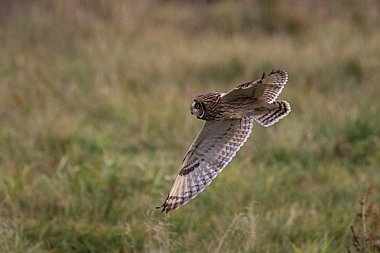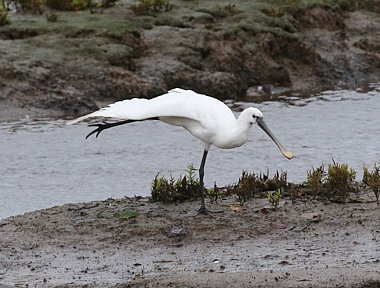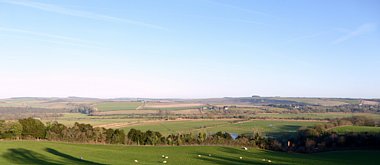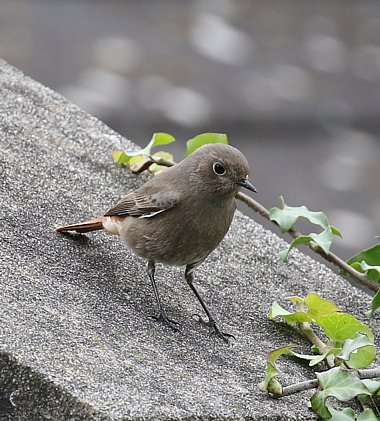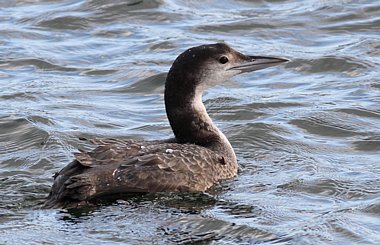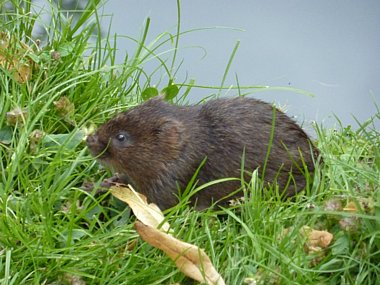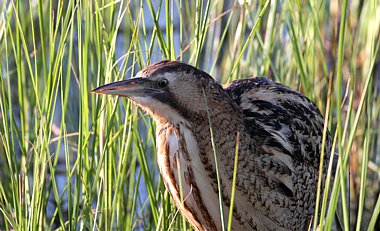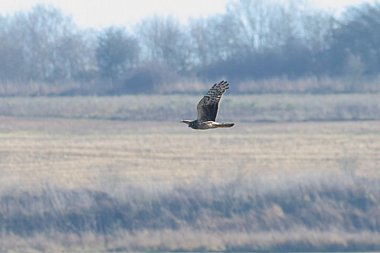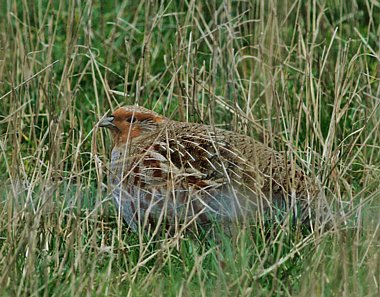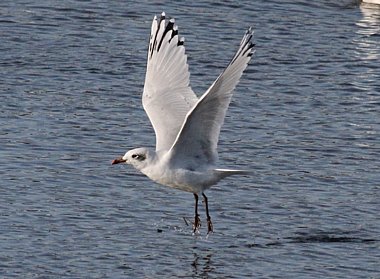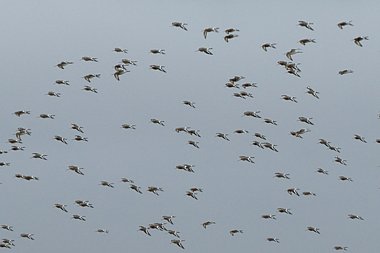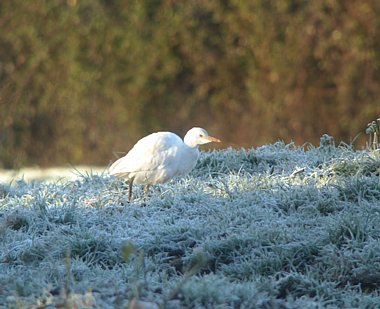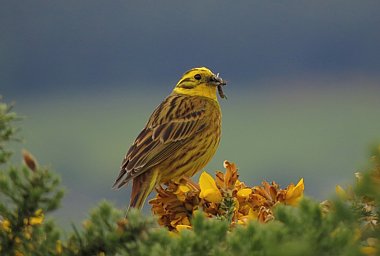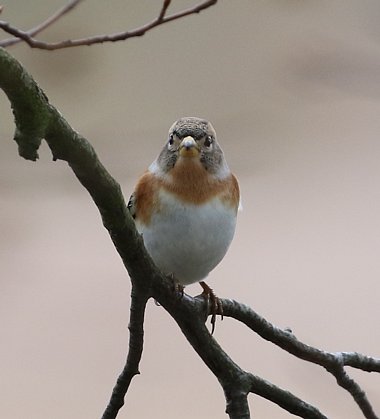West Sussex and Kent in Winter
Winter birding in quiet southern locations
| Destination | |
|---|---|
| Focus | |
| 2025 Dates | |
| Duration | 8 Days |
| 2025 Price | Price TBC |
| Max Group Size | 7 |
Sussex is a delightful County, with huge potential and an array of mixed winter habitats all of which can be explored in short journey times. Among top sites are the sheltered harbours of Chichester and Pagham where impressive numbers of coastal species can be found taking advantage of generally mild conditions; huge tracts of West Sussex downland, the commons and woodland being prime birding sites for many scarce UK species, and the bird rich Arun Valley, which teems with wildfowl at this time of year. We also spend time in East Sussex, relocating to Rye for two nights to enjoy great wildlife watching around the Rye Harbour Nature Reserve and the Dungeness Peninsula, just over the border in Kent.
The first part of our week will be spent exploring the Selsey peninsula, which includes the famous RSPB Pagham Harbour Nature Reserve, with its huge numbers of wintering species of waders, ducks and geese. The eastern part of Chichester Harbour has many good sites too, such as East Head, Dell Quay and Fishbourne, as does RSPB Medmerry reserve. During this trip our list could top 120 birds and we target some difficult species including Bewick's Swan, Dark-bellied Brent Goose (flocks of thousands) among which Black Brant is regular. Offshore we have chances of all three diver species, Slavonian Grebe both scoters, while one of the features of this part of the coast are the huge flocks of wintering Mediterranean Gulls, often in excess of 100 individuals.
A variety of waders can be found including Avocet, Golden Plover, Knot, Sanderling, Jack Snipe and both godwits, and our local knowledge of bird locations and tides helps us to seek out the birds. Whimbrel, Spotted Redshank, Greenshank and Green Sandpiper may be seen, and wintering Sandwich Tern and Cattle and Great White Egret are fast becoming regular. It's not uncommon to find a Snow Bunting or Black Redstart at the coast, while sheltered copses and hidden sewage works can hold Firecrest, Chiffchaff and scarce Siberian Chiffchaff. The West Sussex Downs offer great birding with large, winter flocks of Yellowhammer, Linnet, Chaffinch, Reed and Corn Bunting and in most years, Brambling too. This area holds possibly one of the highest densities of Grey Partridge in the UK and the habitat provides plenty of prey for raptors and owls including Hen Harrier, Red Kite, Peregrine, Merlin, Short-eared, Barn and Little Owl. Dartford Warbler is another target on this trip, we may find a Great Grey Shrike, and a visit to Dean Woods might give us Hawfinch, Common Crossbill or Marsh Tit, and we have a chance of an early displaying Goshawk too.
In the east of the county, we explore Rye Harbour LNR and Pett Level, great sites for wintering wildfowl and waders which can often include Russian White-fronted Goose The unique wild Dungeness peninsula is the largest shingle promontory in Europe. These sites hold important wintering numbers of grey geese and ducks including Scaup, Long tailed Duck, Smew, Goosander and Goldeneye plus both species of Scoter. The sea from Dungeness can be busy with birds as Red-throated Diver, Razorbill, Guillemot, Gannet, Kittiwake and Fulmar pass. This is one of the best places in the UK to see Caspian Gull, and most winters Glaucous and Iceland Gull are present too. Long-eared Owl can occasionally be found roosting in quiet places and Bearded Tit and Water Rail are more frequently seen or heard. Bittern and Kingfisher may also be seen, and Dungeness has a history of attracting a rarity or two in winter!
Day 1: Saturday - Meet and Pagham Harbour birding
We meet at the railway station in Arundel at 14:00. From here we drive to Pagham Harbour, where we will soon be scanning vast flocks of winter waders, ducks and grebes. Offshore we should find Slavonian Grebe, Red breasted Merganser with perhaps Red-throated Diver and sea duck too. The Norton shingle spit is a favourite location to find Mediterranean Gulls feeding in the surf and from here we can also search through the huge flocks of Dark-bellied Brent Geese for any hidden Black Brant. Marauding Peregrine frequently cause mass panic hunting over the harbour, and if time permits we may try for any owls that have been reported.
Day 2: Sunday - Selsey Peninsula
A full day exploring the Selsey Peninsula, including many parts of Pagham Harbour less widely known. Taking a sea-watch off Selsey Bill (jutting 8 miles into the English channel) we are likely to find Gannet, Kittiwake and auks plentiful with good chances of Red-breasted Merganser, both scoters, Slavonian and Great-crested Grebe, Great Northern Diver or even Black-throated Diver. Back on land, Black Redstart can be found in sheltered spots and Firecrest, Chiffchaff and sometimes Dartford Warbler overwinter. Waders in the harbour usually include Knot, Dunlin, Ringed Plover and both Bar-tailed and Black-tailed Godwit. Avocet and sometimes Whimbrel can be found in certain spots, and the distinct 7-note flight call of the latter is a lovely sound in the depths of winter. On Sidlesham Ferry we scan from the cosy new hide, sometimes finding a wintering Green Sandpiper. Other parts of the harbour we visit for Rock Pipit, Water Rail, Kingfisher or perhaps Bearded Tit and using the local grapevine we may again make a late-afternoon attempt for any reported owls.
Day 3: Monday - Arun Valley
We set off for Arundel where top targets will be Bewick's Swan and Siberian Chiffchaff, with Great White Egret, Mandarin Duck, Firecrest, Cetti's Warbler, Bullfinch, Peregrine and Marsh Harrier also possible. The water meadows of the Arun Valley can teem with winter thrushes, plus masses of Wigeon and Teal, and if time permits we will try for Water Vole at known sites. The wild South Downs are one of the best sites in the UK for Grey Partridge and walking over these gentle, rolling hills we should see large flocks of finches feeding in stubble and field margins. In turn these attract hunting Hen Harrier and the occasional Merlin while Raven is common here. As dusk approaches we stake out a regular site for Short-eared and Barn Owl, both of which can be confiding in cold weather, and Brown Hare are likely too.
Day 4: Tuesday - Chichester Harbour
A superb day in the field, exploring the eastern parts of Chichester Harbour including East Head - a sand spit curving out into the harbour. A great place to watch Sanderling dart back and forth at the tideline and where offshore channels can hold any sea duck or divers. The sheltered waters of the harbour sometimes have Sandwich Tern and there is a small population of Common Seal, it's always worth looking for this engaging species. Around the margins of this extensive sandspit we may find Stonechat and Reed Bunting with plenty of confiding Skylark feeding at the tidal edge. The mudflats and foreshore attract thousands of Dark- bellied Brent Geese and the adjacent greensward often has a swirling mass of Golden Plover and Lapwing. Snowhill Marsh is worth a check, offering a good chance of Black-tailed Godwit, Greenshank, Spotted Redshank and elusive Jack Snipe. We will visit known sites for Firecrest and should see good numbers of Yellowhammer, Rock Pipit, Grey Wagtail, Kingfisher and much more during a busy day.
Day 5: Wednesday - West Sussex Commons and Dean Woods
We will have a little time in the Chichester area to catch up with any species that we may have missed, and the peninsula often has a rarity! We may be able to sneak over the border into Hampshire to look for Black-necked Grebe which winters around Hayling Island, before visiting one of the West Sussex Commons to try for Dartford Warbler, Stonechat or perhaps Woodlark. In the afternoon we explore West Dean Woods for Red Kite, Raven, Common Buzzard, and winter thrushes. Taking a walk deep into the woods we have an excellent chance to view Hawfinch, this valley being the one of the only regular sites for this species in the county. If the weather conditions are fine, we have the possibility of watching soaring Goshawk as their display season begins. Brambling, Linnet and Yellowhammer feed in the game crops at woodland fringes with Marsh Tit, Nuthatch and Treecreeper often vocal from the trees. Tawny Owl can be heard calling late-afternoon and at dusk we can check out a regular site for Little Owl.
Day 6: Thursday - East Sussex including Rye Harbour
We transfer to Rye in East Sussex, driving roughly two hours though any good birds en route will be welcomed and we may make a diversion to add to our list. On the west side of Rye are Pett Pools and Levels, always worth checking, and watching from the sea wall we have a great view inland to where grey geese graze by day. Russian White-fronts are likely with other possible species including Ruff, Redshank and Lapwing. Offshore, the sea holds good numbers of Red-throated Diver, Common and Velvet Scoter and in the afternoon we visit Rye Harbour, an excellent reserve with extensive gravel lagoons and hides, supporting good numbers of wildfowl and waders which in turn attract hunting Marsh Harrier and Peregrine. A few Twite have spent recent winters on the reserve, Great White Egret are regular and late-afternoon we may get lucky with Bittern, Water Rail or Barn Owl as they become more active.
Day 7: Friday - Dungeness
We spend our final day birding the Dungeness Peninsula just over the border in Kent. A totally unique habitat comprising the largest shingle peninsula in Europe within which resides Dungeness Bird Observatory, RSPB Dungeness Reserve and an atomic power station! On the way we stop at Scotney Gravel Pit for ducks, grebes, grey geese, Marsh and Hen Harrier, Merlin and Peregrine. Tree Sparrow and Corn Bunting can be found around the farms. Continuing on to Dungeness RSPB, we use the facilities and perhaps grab a cuppa in the warmth of the centre (RSPB Membership Cards required) while watching Tree Sparrows on feeders. We visit comfortable hides and walk good trails seeking birds of interest such as Bittern, Smew, Goosander, Goldeneye, Bearded Tit, Cetti's Warbler, Kingfisher, Great White and Cattle Egret. Moving to the beach, we check out the loafing gulls for Caspian Gull - seen every winter, they can rarely resist a piece of bread! Around the fishing boats we may find Glaucous or even an Iceland Gull especially if the weather has been cold. Offshore the sea can be busy with Red throated Diver, Common Scoter, Gannet, Kittiwake and auks. All in all, a fine site to conclude our holiday.
Day 8 : Saturday - Departure
We leave the Rye area, returning to our original hotel to pick-up vehicles and for drop-offs at Rye Railway Station for trains departing after 09:00, or Arundel Railway Station for trains departing after 11:30.
Please note: all itineraries are given as a guide only. Actual holiday content may vary according to the judgement of your guide, and elements beyond our control (eg weather).
Expect a wide variation in weather conditions. The county can at times be wet and windy, however we may also experience some nice dry weather. Sunshine, rain and strong winds are all possible, and you will probably experience a bit of everything. Please bring walking boots or shoes, weatherproof clothing and a small rucksack.
We take things at a slow pace, though will cover a few miles of walking daily mainly on good quality paths but at times over rougher or uneven ground, through fields or across sandy beaches. Rare and target birds are often found in inconvenient locations, involving several gates and stiles to be climbed or potentially a long walk in exposed locations. Transfer between sites is by mini-bus.
Your Leader
Experienced leader from the Heatherlea Team
What's included in your 'West Sussex and Kent' holiday price:
- Seven nights comfortable en-suite hotel accommodation. Guests are never expected to share. All rooms are en-suite. Full details with your joining pack.
- Full breakfast and dinner from Saturday evening until Saturday morning, packed lunch daily.
- Guidance from a professional Group Leader.
What's not included in your 'West Sussex and Kent' holiday price
- Travel to the meeting point in Arundel and any onward travel from where the holiday finishes.
- Insurance, drinks and other items of a personal nature.
Other birding and wildlife holidays in Southern England
- Isles of Scilly for birders
- Cornwall in Spring
- Forest of Dean and Somerset Levels
- Isles of Scilly in Spring
- Sussex, Hampshire and Kent in Spring
- West Cornwall in Autumn for birders
Why choose Heatherlea for your birding and wildlife holiday?
Heatherlea is one of Britain's leading wildlife holiday operators. In 2019 we celebrate our 29th Anniversary with more choice than ever, both in Scotland and overseas. Relax and enjoy yourself, as we do all the planning! Above all, we make it our business to show key wildlife to you. Our fully inclusive guided holidays concentrate on the real experience, and we take time to ensure that each of our guests enjoys everything we do.
- We have been organising birding and wildlife holidays for 30 seasons, and have a highly experienced and capable office team. We also offer a telephone and email service outside normal office hours.
- We are a small company, run BY birders FOR birders. Come and see!
- Heatherlea are Mainland Scotland’s FIRST ‘5-Star Wildlife Experience!’ This is the highest available grading, classified as ‘exceptional’ by visitScotland.
- Heatherlea hold full Tour Operator Insurance for your added protection.
- Heatherlea is a limited company, registered in Scotland. We are also registered to pay VAT, which is included in your holiday price as quoted on this page.
- Once your holiday is confirmed in writing by us, we promise not to surcharge the price for any reason.


